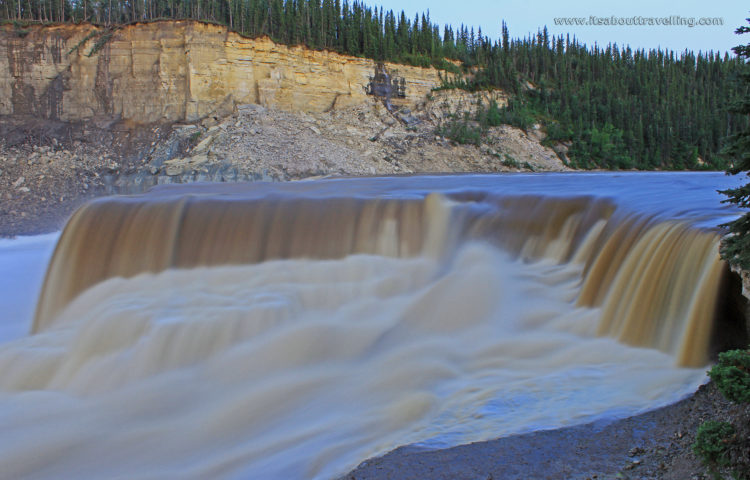Louise Falls is a gem of a waterfall located on the Hay River in the Northwest Territories of Canada. Honestly, when we planned to take a lengthy road trip up to the Northwest Territories from Ontario, we really didn’t know what to expect. Would there be any people? Any services? Anything but barren rock and forest? Would the people that were there rob us and leave us for dead?
The second Territorial Park you come across when entering from Alberta is Twin Falls Gorge. Upon arrival, all worries flew out the window. There were people and they were incredibly friendly and helpful. There were flush toilets and even showers at the campground. You could get gasoline and groceries fairly nearby. And, the scenery was nothing short of amazing.
Louise Falls
Louise Falls is the second of two waterfalls that make up the Twin Falls Gorge. Upstream, about three kilometres to the south, is the taller yet no more or less incredible, Alexandra Falls. Louise Falls is located directly at the campground, while Alexandra can be found via an easy trail along the upper rim of the gorge (there is also a day-use parking lot off the MacKenzie Highway, right next to that waterfall).
The week prior to our arrival at the start of July, 2016 saw large amounts of rain fall on northern Alberta and British Columbia. Is was to the point where some communities were left under water. When we arrived in Northwest Territories, all that water was draining north. The Hay River, along with all other major rivers we discovered on our journey, was quite swollen.
The waterfall stands around 15 metres or 50 feet high while the width varies with the water volume. There is a 138 step spiral staircase that takes you from the top of the gorge to near the base of the waterfall.
The images shown here that are long exposure (with the water blur) are taken from the area found at the bottom of the spiral staircase. It should also be noted that the water blur images were taken at midnight on July 4 and were all around four second exposures.
The sun officially sets around 11:15pm on those early July nights. However, what follows is nothing more than dusk or twilight until the sun again rises around 4am. For photographers, there is basically an extended golden hour and extended blue hour.
Twin Falls Gorge Territorial Park
Camping at Twin Falls Gorge typically costs less than $30 per night if tenting. The sites are exceptionally large, around 2-3 times larger than sites at say, Banff or Jasper. The contractors that run the campground are amazingly friendly and helpful.
Wildlife abounds in NWT but there was no danger of bears or other creatures around the camp.
The waters of the Hay River empty into Great Slave Lake at the town of Hay River. Eventually, the water empties into the Arctic Ocean.
Although not visible on the other side of the gorge at this point, in the not too distant past the area was engulfed in flame as a forest fire threatened to jump the gorge. Not far downstream, the trees are burnt right up the edge of the gorge.
A question often asked is whether the roads are paved. Yes and no. The road from Alberta to Hay River and to Yellowknife is paved. A lot of the roads to the west, looping back down to the border with British Columbia are still gravel. Also, the road east to Wood Buffalo National Park and Fort Smith has a long stretch of gravel.
The video below was taken at different times of day from various angles. The first four clips are taken at midnight with no artificial lighting. If you like what you see, please give it a ‘Thumb’s Up’ on YouTube. If you love what you see, please share with friends!
Louise Falls Video














